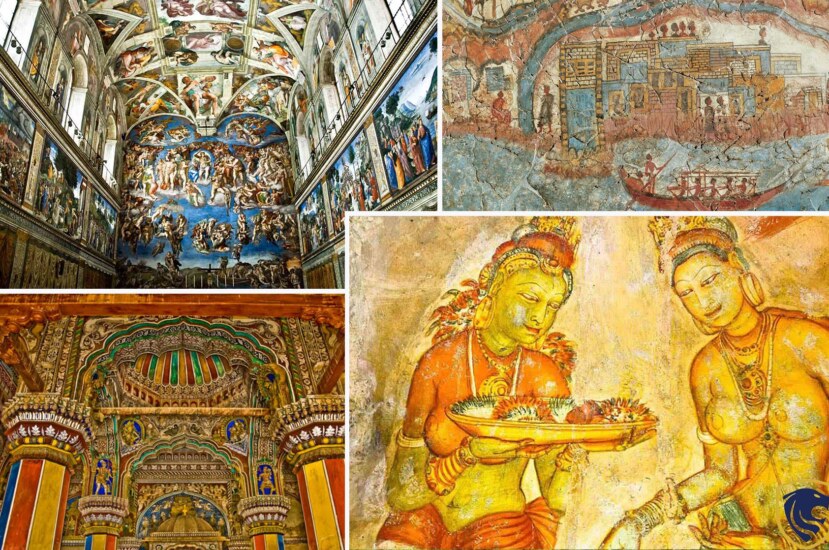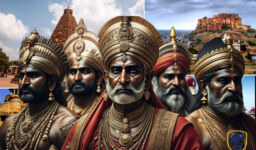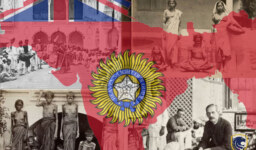The name “fresco,” which signifies “fresh” in Italian, originated from a method of painting over freshly laid building plaster using a combination of water and coloring. Carbonation causes the pigment particles in the lime-based plaster to come together when it dries outside. As a result, the wall’s stability and the painted picture are actually improved by the fresco painting process.
The beauty of fresco painting is found because of its durability. Most of the fresco paintings indicate different instances of stories, legends and folk tales. Moreover frescoes are a great source learn about the lifestyle of a specific era.
The Creation of Adam by Michelangelo
The most well-known fresco of them all must be one of Michelangelo’s masterpieces. It is non other than the Creation of Adam. The genesis of man as it is recounted in the book of Genesis is shown in the 280 cm 570 cm (9 ft 2 in 18 ft 8 in) fresco. It is a piece of a collection of biblical scenes that decorate the chapel’s ceiling. It differs from usual creation paintings from that era and prior by resembling Michelangelo’s signature sculpture-like paintings. The major protagonists of the fresco is God. The God is portrayed as an elderly, gray, and manly figure wearing simple clothing. Further, Adam, who is seen relaxing and at peace in the presence of his Creator.

The Creation of Adam by Michelangelo
A woman with a tiny kid standing next to her and two seeming wingless angels supporting the God. The exact interpretation of many aspects of the artwork is still up for debate among historians. However, some contends that the figure must be Eve, the first woman, who is waiting to be produced from Adam’s rib. Also, some claim that Mary, Jesus’ mother, is depicted, and the little kid is Mary’s future son. As the painting’s title and commission indicate, God creating Adam is symbolized by the touching of hands. Modern interpreters, however, are searching for other interpretations, the majority of which pose more problems than they do solutions.
The Last Supper by Leonardo da Vinci
Da Vinci was regarded as one of the outstanding fresco painters of the Renaissance era. He lived and worked during the same period as Michelangelo. The Last Supper which is a painting that measures almost 8.8 meters in width and 6 meters in height, was painted on a wall of the Santa Maria delle Grazie Convent in Milan, Italy, in 1498. It is still being conserved and displayed today. In the fresco, Jesus is shown sharing his final dinner with his friends and confessing his betrayer, who subsequently hands him over to the authorities so he may be executed in Jerusalem. Also, this scene is shown from the Bible.

The Last Supper by Leonardo da Vinci
The followers would have been younger than they appear in various biblical stories, and they would have reclined for their meal rather than facing the audience. Having said that, it may have just been a trick used by Da Vinci to make every participant visible to the audience. It is much like contemporary cinema and television camera footage does today. As Da Vinci painted this fresco on a stone surface and sealed it with tempura it caused moisture to pool on the surface. That led this fresco to undergo several repair attempts to preserve it.
The Paintings of Sigiriya
At Sigiriya, King Kasyapa founded his luxurious empire in 477–495 AD. First, he attempted to portray the Buddhist fabled city of Alakamanda by painting a 200-meter-tall rock white. He didn’t like the appearance and asked his architects to paint 500 half-naked ladies in vivid colors in highly detailed frescoes to embellish the western face. This fresco lustro ensemble required a difficult painting technique. Because bamboo scaffolding covered the rock, forcing stonemasons and painters to carry materials up the wall by hand. There are currently just 20 of the paintings remaining, yet they are still in outstanding condition despite entertaining the visitors for 1600 years.

The Paintings of Sigiriya
It is generally acknowledged that they served as the model for the bare-breasted, golden-skinned ladies who make up the “Sigiri Frescoes. According to the historians these women who are featured in these artwork might have been royal family members, notably Kashyapa’s daughters. It is declared based on the elaborate and expensive gem-studded jewelry they are wearing. The murals are also said to show apsaras, or deities, coming down from the skies to bless the castle. Similar representations from the Gupta era at India’s Maharashtra state’s Ajanta Caves provide as confirmation of this. Some historians even contend that the images reflect heavenly nymphs, who were said to have guarded the Rock Castle.
Thanjavur Maratha Palace, Tamil Nadu
Be sure to visit the Thanjavur Maratha Palace if you have Tamil Nadu on your bucket list for a Fresco Tour of India. I mean you should have this amazing country on your list if you love frescoes. Because Indian frescoes are colorful just like their culture. Although though it was constructed in the 1530s, the Bhonsle family, who controlled Tanjore, still calls it home. It still houses the kings and queens. Moreover, it has several sculptures and artifacts from antiquity. It also houses one of the oldest libraries in all of Asia. Also, it is one of the few Maratha locations in South India.

Thanjavur Maratha Palace, Tamil Nadu
Ajanta caves in Maharashtra, India
One of the most exquisite fresco paintings in the entire world may be seen at the Ajanta caves in Maharashtra, India. These show scenes from the Jataka tales. That narrates the Buddha’s earlier lives. The Avalokiteshwara Padmapani and the Vajrapani murals in Cave 1 are particularly fascinating. Moreover, according to the historians ancient Buddhist monks used to reside in the chaityas and viharas which are located here. Further, Buddhists used here to worship in the past.

Ajanta caves in Maharashtra, India
The statue of the Parinirvana Buddha, often known as the reclining Buddha, should not be skipped.
On the way to Aurangabad city, there is a viewpoint from where you can see the entire network of caverns as well as a stunning waterfall. Unfortunately, a lot of the paintings have faded over time. But the Indian Archeology Department is curranty taking different measures to restore them and protect this Indian heritage.
The Frescoes of Akrotiri
Early Greek frescoes were confined to basic, monochromatic walls painted in red and black. They resemble the images of certain athletic shapes sometimes mentioned in literature about the Olympic Games. One of the earliest civilizations to depict natural landscapes in paintings without include any people was the Minoan civilization. That was based in Knossos, Crete. After being momentarily submerged by volcanic eruptions, walls were decorated with gorgeously colorful depictions of nature. Moreover , they shows everyday life. Those were discovered in excavations.

The Frescoes of Akrotiri




